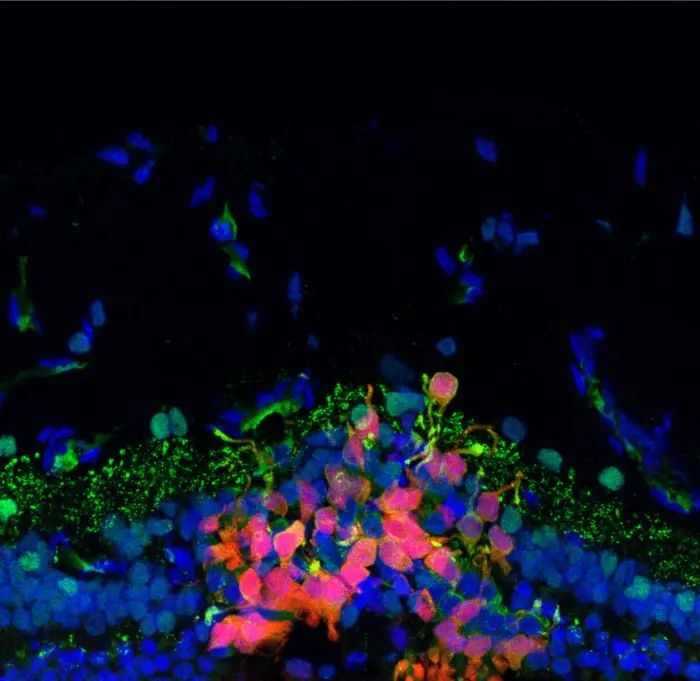Research aims to regenerate photoreceptors cells via stem cell-based therapy
A multi-institutional effort led by researchers at the University of Pennsylvania is taking steps to develop an effective technique to regenerate photoreceptors cells and restore sight in patients with vision disorders.
Following a transplantation procedure, human photoreceptor precursor cells labeled red migrated and integrated into a degenerated canine retina. The green label is a synaptic maker, suggesting the transplanted cells began forming a connection with second-order neurons in the retina. (Image courtesy of the Beltran lab/Stem Cell Reports)

What if, in people with blinding retinal disorders, one could simply introduce into the retina healthy photoreceptor cells derived in a dish from stem cells, and restore sight?
According to a news release form the University of Pennsylvania, it is a straightforward strategy to curing blindness, yet the approach has been met with a number of scientific roadblocks, including introduced cells dying rapidly or failing to integrate with the retina.
A new study, published in Stem Cell Reports, overcomes these challenges and marks significant progress toward a cell-based therapy. The work, led by a team at the University of Pennsylvania School of Veterinary Medicine, in collaboration with researchers at the University of Wisconsin-Madison, Children’s Hospital of Philadelphia, and the National Institutes of Health’s National Eye Institute (NEI), introduced precursors of human photoreceptor cells into the retinas of dogs. A cocktail of immunosuppressive drugs enabled the cells to survive in the recipients’ retinas for months, where they began forming connections with existing retinal cells.
“In this study, we wanted to know if we could, one, improve the surgical delivery of these cells to the subretinal space; two, image the cells in vivo; three, improve their survival; and four, see them migrate to the layer of the retina where they should be and start integrating,” said William Beltran, a professor of ophthalmology at Penn Vet and senior author on the study. “The answer to all those questions was yes.”
Beltran and Gustavo Aguirre at Penn Vet have long been interested in addressing retinal blinding disorders and they have had great successes to date at producing corrective gene therapies for conditions with known causative genes. But for many cases of inherited retinal degeneration, a gene has not been identified. In other patients, the disease has progressed so far that no photoreceptor cells remain intact enough for gene therapy. In either scenario, a regenerative medicine approach, in which photoreceptors could be regrown outright, would be extremely valuable.
To develop a cell therapy, Beltran’s team joined with groups led by John Wolfe of CHOP and Penn Vet; David Gamm at the University of Wisconsin-Madison; and Kapil Bharti at the NEI, in a consortium supported by the NEI’s Audacious Goals Initiative for Regenerative Medicine. The partnership combined Beltran’s team’s expertise in canine models of retinal degeneration and vast experience in cell-based therapy approaches from the Wolfe, Gamm, and Bharti labs.
According to the news release, photoreceptor cells, which are made up of rods and cones, constitute a layer of the outer retina critical to initiating the process of vision, whereby the energy of light transforms into an electrical signal. To function properly, they must form a connection, or synapse, with cells of the inner retina to pass along the visual information. Thus, the goal of this cell therapy is to recreate this layer and enable it to integrate with the retina’s other cell types in order to relay signals from one layer to the next.
In the current work, the team used stem cell-derived precursors of human photoreceptor cells developed in the Gamm lab to serve as the basis of the cell therapy. In collaboration with the Bharti lab, they developed a new surgical approach to inject the cells, which were labeled with fluorescent markers, into the retinas of seven dogs with normal vision and three with a form of inherited retinal degeneration, then used a variety of non-invasive imaging techniques to track the cells over time.
“The use of a large animal model that undergoes a naturally occurring form of retinal degeneration and has a human-size eye was instrumental to optimize a safe and efficient surgical procedure to deliver doses of cells that could be used in patients,” Gamm said in the news release.
The researchers observed that cell uptake was significantly better in the animals with retinal degeneration compared to those with normal retinas.
“What we showed was that, if you inject the cells into a normal retina that has its own photoreceptor cells, the retina is pretty much intact and serves as a physical barrier, so the introduced cells don’t connect with the second-order neurons in the retina, the bipolar cells,” Beltran noted in the news release. “But in three dogs that were at an advanced stage of retinal degeneration, the retinal barrier was more permeable. In that environment, cells had a better ability to start moving into the correct layer of the retina.”
Because the transplanted human cells could be interpreted by the dogs’ immune system as foreign entities, the researchers did what would be done in other tissue transplant procedures: They gave the dogs immunosuppressive drugs. The trio of medications had been tested previously by Oliver Garden, a veterinary immunologist with Penn Vet at the time of the study, who is now dean of Louisiana State University School of Veterinary Medicine.
Indeed, while the injected cell populations declined substantially in dogs that did not receive the immune-suppressing drugs, the cell numbers dipped but then sustained in the dogs that received the cocktail.
The university noted that further characterization of the introduced cells revealed evidence of potential synapses.
“We saw that yes, some are appearing to ‘shake hands’ with those second-order neurons,” Beltran added in the release. “There appeared to be contact.”
The next stage for this project will be to continue optimizing the therapy, and then test whether there is a functional response—in other words, improved vision—in its recipients.